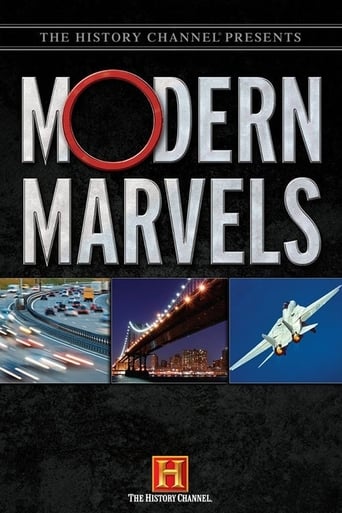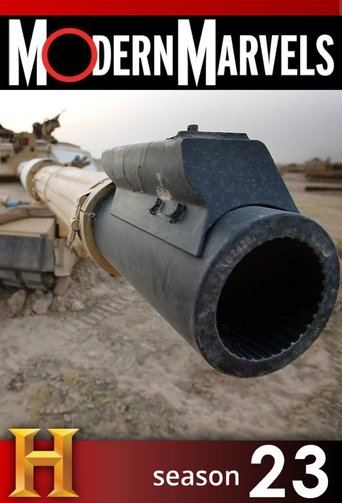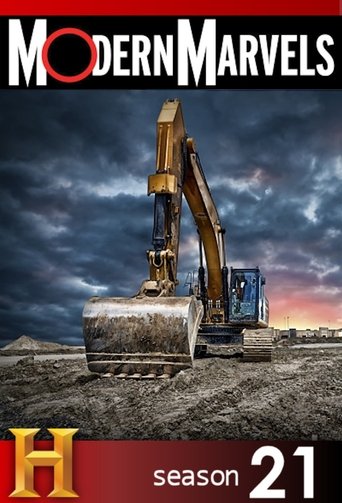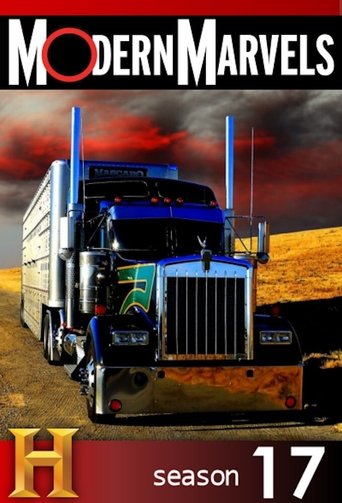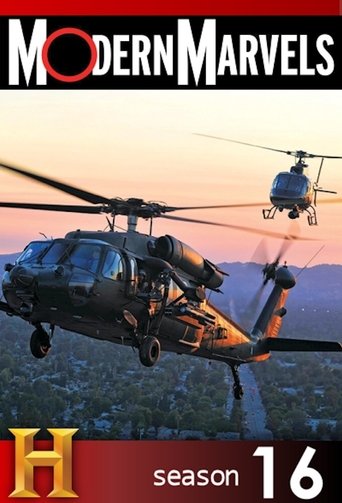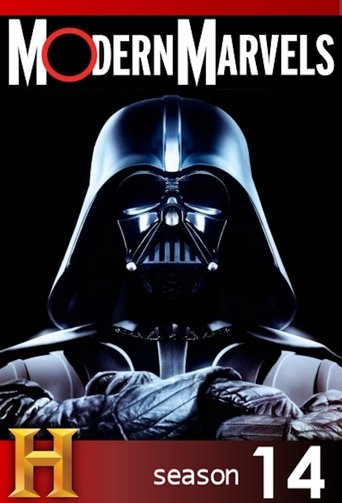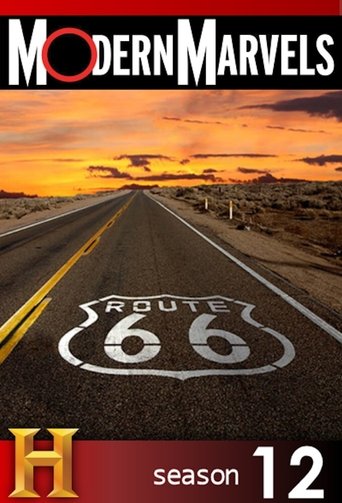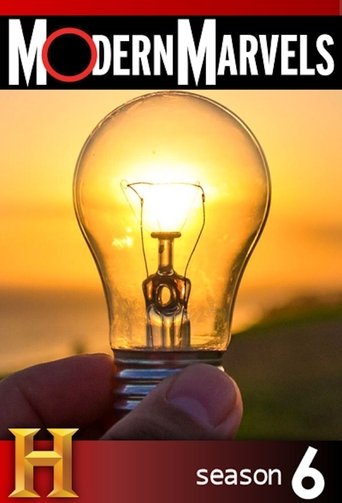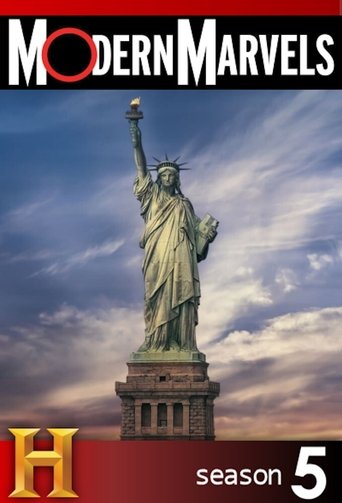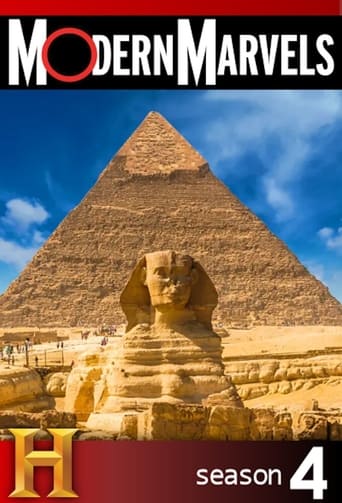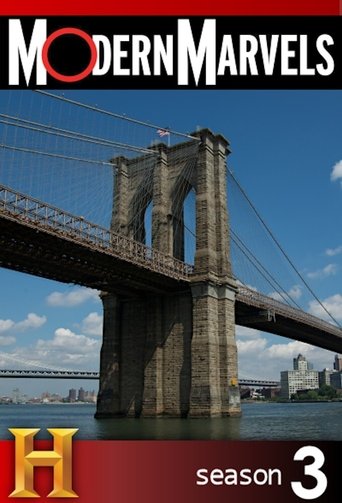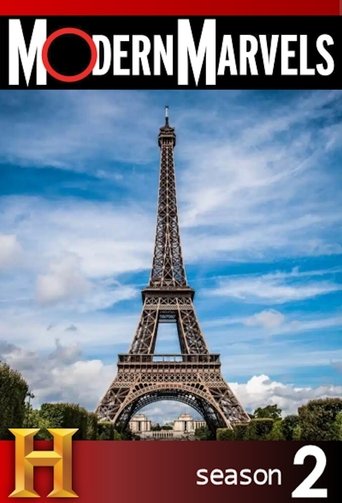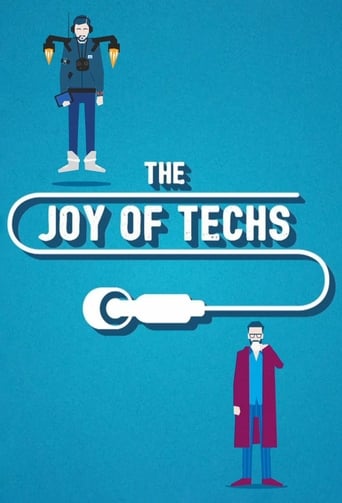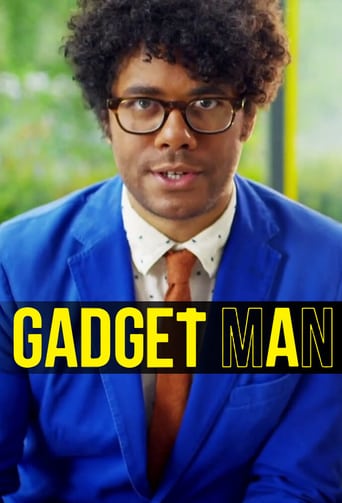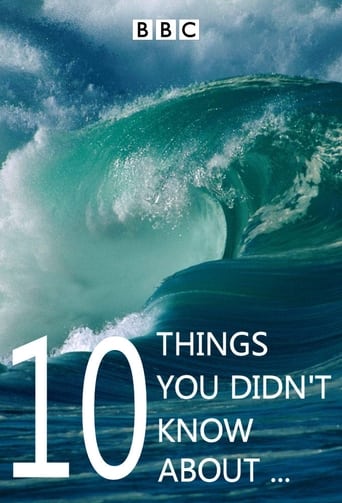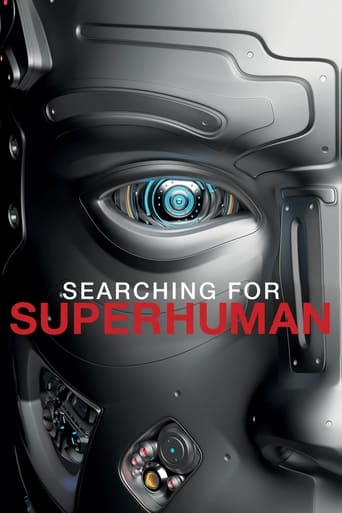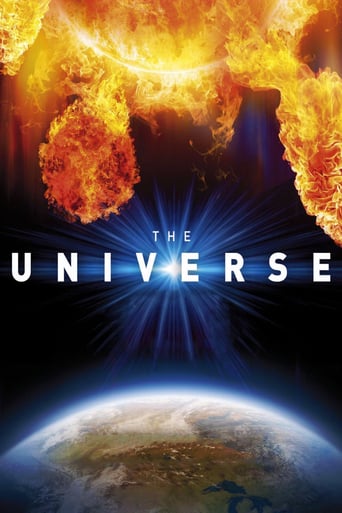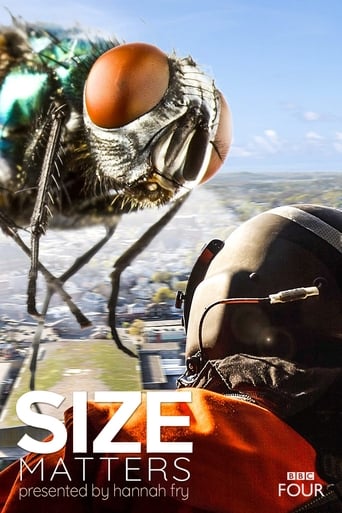Modern Marvels Season 12

HISTORY’s longest-running series moves to H2. Modern Marvels celebrates the ingenuity, invention and imagination found in the world around us. From commonplace items like ink and coffee to architectural masterpieces and engineering disasters, the hit series goes beyond the basics to provide insight and history into things we wonder about and that impact our lives. This series tells fascinating stories of the doers, the dreamers and sometime-schemers that create everyday items, technological breakthroughs and manmade wonders. The hit series goes deep to explore the leading edge of human inspiration and ambition.
Watch NowWith 30 Day Free Trial!
Modern Marvels
1993 / TV-PG



HISTORY’s longest-running series moves to H2. Modern Marvels celebrates the ingenuity, invention and imagination found in the world around us. From commonplace items like ink and coffee to architectural masterpieces and engineering disasters, the hit series goes beyond the basics to provide insight and history into things we wonder about and that impact our lives. This series tells fascinating stories of the doers, the dreamers and sometime-schemers that create everyday items, technological breakthroughs and manmade wonders. The hit series goes deep to explore the leading edge of human inspiration and ambition.
Watch Trailer
Modern Marvels Season 12 Full Episode Guide
Priceless collections. Compilations devoted to with such passion, entire lives have been spent perfecting them. From rescued trash to treasure troves with values known to only the most discerning eye, people collect for many reasons. For some, the thrill is in the find; for others, collecting is an escape from daily life. But all collectors have one thing in common–they love it! This 2-hour special shows what people hoard–from the largest Star Wars collection to the largest private collection of Elvis memorabilia–and the extent to which they go to satisfy their hobby, their passion, their addiction. Among the collections we view are Steven Seagal’s ancient Japanese swords and rare guitars, Arnold Palmer’s golf clubs (over 10,000), and Penny Marshall’s sports memorabilia (she often battles Billy Crystal for the top online bid).
They’re nature on a rampage. The size and intensity of hurricanes make them the most feared and destructive of all storms. Explore how hurricanes start, how scientists track them, and how if at all possible they can be stopped. Take a ride on a hurricane “chaser” plane as it flies directly into the eye of hurricane Wilma, collecting important barometric pressure and wind velocity readings. In this hour we’ll also track the historical highlights of hurricanes, and the history and development of such important hurricane research tools as radar and weather satellites. We’ll delve into the construction of buildings that weather hurricanes better than traditional structures and examine how modern skyscrapers are built to stand up to hurricane force winds.
Journey underground and backstage at the technological marvel that is Walt Disney World. Enter a make-believe world spanning some 27,000 acres, brought to life by cutting-edge technology. What was once Florida swampland now boasts the world's largest theme park. The ride technology ranges from space-age centrifuges to enhanced motion vehicles powered by 3,000 PSI of hydraulic pressure. And hundreds of audio animatronics brought to life through the power of pneumatics, hydraulics, and electrical systems. Walt Disney World is made up of four separate theme parks, each with its own innovations: the 107-acre Magic Kingdom, Epcot, Disney-MGM Studios, and Disney's Animal Kingdom. The four parks are all part of a megaplex of a resort. Twice the size of Manhattan, it was the final vision and crowning achievement of a man who spent more than 40 years pushing the limits of technology to create entertainment magic: Walt Disney.
They crunch; they ooze; they crackle; they pop–mmmmm, yeah! Soft drinks, donuts, meat snacks, popcorn, and gum. What's your weakness? From the handmade treats of the earliest civilizations to hi-tech mass production, these snacks are borne of man's need to feed his cravings. Join us for an hour-long tasty treat as we examine the history of snackfoods and check out how they are made today.
The hardware store is the epicenter of the construction world for both the weekend handyman and professional builder. Many of the items found in hardware stores are so common that it’s easy to forget that when they were invented, they represented technological breakthroughs–some even revolutionized entire industries. We examine various tools and see how they’ve evolved, including the wrench, measuring and demolition tools, rope, sandpaper, and locks and keys. Whether you’re looking for an ancient tool like a hammer or a modern one like an electronic lock, you’ll find it at the hardware store–the place to go when things fall apart or when you decide to build your dreams from the ground up.
For most of us, cars are an ordinary fixture of daily life. But then there are custom cars–literal labors of love. Supercharged hot rods, sublimely sculpted classics, flashy tricked-out lowriders, neon-bright “import tuners”–an eye-popping blend of fine art and mechanical know-how. In this episode, we trace the history, technology, and cultural connections between successive generations who have turned the common car into an American art form. We’ll ride with hot rodders and lowriders and visit the speed shops and paint shops where ordinary cars become art.
Nearly 500 years after his death, Leonardo da Vinci still intrigues us. Most people think of him as a great artist, but he was also a remarkable scientist and inventor. His love of mechanics was unparalleled and he filled his notebooks with pages of incredible machines–from weapons of war to "Ships of the Skies", from submarines and scuba suits to robots and an analogue computer…even contact lenses and alarm clocks! How did a 15th-century man envision such modern innovations? If we follow his plans, would any of his designs work? We need wonder no more. With recent technological advances and new materials, we're the first generation able to bring Leonardo's drawings to life–to learn whether his "mechanical dreams" were workable plans. We explore the fascinating intersection of his art, science, and engineering marvels, and use them to offer insight into this "Genius of Geniuses", who remains as elusive as Mona Lisa's smile.
At the center of the American Dream is the home–and at the center of its creation or renovation is the lumberyard. We'll explore the options lumberyards provide for builders and renovators–from natural to engineered woods. We'll show how plywood and pressed woods are made, trace exotic woods to jungle and desert, visit a special lumberyard that deals in recycled and antique woods, and go on an underwater expedition as divers locate ancient logs buried in the Great Lakes and New Zealand. We'll see how 50,000-year-old ancient Kauri wood is "mined" from a bog and is now all the rage among those who live in mansions and travel on yachts. From the lowly 2-by-4 used to build a tract home, to a reclaimed set of historic planks used to make a million-dollar bar in a 5-star hotel, this eye-opening program hits the nail right on the head.
It's one of the world's oldest and most beloved beverages–revered by Pharaohs and brewed by America's Founding Fathers. Today, brewing the bitter elixir is a multi-billion-dollar global industry. Join us for an invigorating look at brewing's history from prehistoric times to today's cutting-edge craft breweries, focusing on its gradually evolving technologies and breakthroughs. We'll find the earliest known traces of brewing, which sprang up independently in such far-flung places as ancient Sumeria, China, and Finland; examine the surprising importance that beer held in the daily and ceremonial life of ancient Egypt; and at Delaware's Dogfish Head Craft Brewery, an adventurous anthropologist and a cutting-edge brewer show us the beer they've concocted based on 2,700-year-old DNA found in drinking vessels from the funerary of the legendary King Midas.
It’s another chapter of complex, deadly and controversial engineering failures, using 3-D animation, forensic engineering experts, and footage of the actual disasters to understand what went wrong, and how disaster has led to improvement. In Sun Valley, California, weeks of record rain turn a crack in the middle of a street into a 200-foot long sinkhole. Months later, rain led to the Laguna Beach, California landslide, which destroyed 11 homes and caused millions in damage. On May 23, 2004, four people were killed when the roof of the new Terminal 2E at Charles de Gaulle International Airport in Paris collapses. Other disasters: the 1931 crash of Fokker F-10 passenger airplane with coach Knute Rockne aboard; the sinking of the coal ship Marine Electric off the coast of Virginia; and the blinding reflection of the new Walt Disney Concert Hall in Los Angeles.
At WWII’s outset, US and UK military aircraft designs were woefully behind Germany’s and Japan’s technologically superior planes. But the genius and ingenuity of innovators on both sides of the Atlantic closed the gap. For America, it was a handful of visionaries and their teams; for Great Britain, a creative and thoughtful spirit emanated from the top leadership on down. In this hour, we recount the untold stories of their cutting-edge designs and solutions, some of which proved decades ahead of their time.
Need a car part or an accessory to give it personality? Since 1903, when Sears dedicated a portion of its catalog, the automotive after-market grew into a billion-dollar juggernaut. We visit Auto Zone, the retail leader, whose largest store carries 25,000 parts. At SO-CAL Speed Shop, a sedan is transformed into a hot rod. Achieving $100-billion in annual sales didn’t happen overnight, but largely on the shoulders of three entrepreneurs–cartoon characters Manny, Moe, and Jack, who were real people. In 1921, they opened their first store in Philadelphia–Pep Auto Supplies. By developing brand names, carrying key parts, and providing hands-on service, they set the standard. Finally, we look at odd products sold by auto stores, discover how Armor All transforms dull interiors into brand-new, and how a tire sealant named Slime may replace the spare tire.
The project was surrounded by secrecy and dogged by controversy from the very beginning. Starting in the late '70s, engineers at Lockheed's legendary "Skunkworks" developed a revolutionary new fighter that was destined to transform aerial combat forever. Little more than a decade later, the F-117 Nighthawk Stealth fighter saw combat for the first time in Panama.
Move over pancakes, step aside bacon! Cereal is arguably the true breakfast king, a $9-billion industry with an indisputable place in pop-culture history. Full of surprise, nostalgia, and fascinating facts, our special celebrates the colorful–and crunchy–saga of a distinctly American breakfast. We see how a Presbyterian minister-turned-health-food-fanatic–Sylvester Graham, of “Graham cracker” fame–turned his countrymen from fried pork breakfasts to grain- and bran-heavy diets in 1824. We reveal the rivalries, tricks, and accidents that turned cereal into a breakfast sensation. And we examine the amazing feats of marketing used to promote the product–from creating iconic characters for packaging, to ingenious prizes that drove consumers to the shelves in droves.
The sugar industry came of age on the backs of slaves toiling in Caribbean fields, and British desire to control production of sugar and its byproduct, rum. Sugar also played a surprisingly critical part in America's battle for independence. Tour a sugar plantation on Maui, Hawaii to get an inside look at how cane sugar is produced today and learn how the sugar stalks are put through an extensive process of extraction and purification–and how a ton of harvested cane results in 200 pounds of raw sugar. Learn the technology behind creating the sweetener in all of its permutations, including corn syrup, brown sugar, powdered sugar, and cube sugar, and how it's used in candies, soda, and sauces as well as more exotic uses such as in pipe tobacco and processed meat.
Traces the origins of this tasty drink from Ethiopia over 1,000 years ago to the espresso-fueled explosion of specialty coffee stores like Starbucks today. Along the way, we’ll see how American companies like Hills Brothers, Maxwell House, Folgers, and MJB grew to be giants. Discover how billions of coffee beans make their journey from coffee farms and plantations, and are processed in gigantic roasting and packaging plants before showing up in coffee cups all over the world. Details the invention and production of instant coffee, decaffeinated coffee, freeze-dried coffee, and the espresso machine. Also, we explain how coffee made shift work in factories possible, while coffeehouses provided a creative cauldron that brewed political and artistic progress in the 18th and 19th centuries. And, we also provide tips on how to make a better cup at home!
The HMS Victory would play a crucial role in the foremost naval engagement in 19th century maritime history, the battle of Trafalgar. This victory was so decisive that no fleet challenged Britain’s Royal Navy for more than one hundred years. Built with enough wood to cover the Empire State Building one and a half times, propelled by wind and firing solid shots from smooth bored muzzle-loading canons, ships like HMS Victory ruled the waves for over two centuries. Manned by a crew of 850 and capable of firing one and a half tons of iron shot in a single devastating broadside, these eighteenth century floating fortresses were as complex and sophisticated in their day as a nuclear-powered aircraft carrier is today. Using color re-enactments and the actual recollections of those who fought on board, this profile goes below the decks of the famous warship.
Since time immemorial, flashes of light have startled our senses and piqued our imagination. But it’s only in recent years that we’ve begun to unlock the secrets behind this terrifying phenomenon, as we learn in this high-tech look at how man has tried to control nature throughout history. Lightning kills nearly 100 people yearly in the United States and injures hundreds of others. Meet men and women who look for new ways of detection, prevention, and how to save lives when Mother Nature strikes!
We begin with electrical linemen perched precariously out a helicopter door, repairing 345,000-volt high-tension power lines. They are part of an army of technicians and scientists we'll ride, climb, and crawl with on this episode. They risk their lives so that we can have the services we take for granted–electric power and 21st century communications. They lay and maintain the wire that connects us one to another, as well as America to the rest of the world. The hardwiring of America is a story that is nearly two centuries old. And though satellites and wireless systems may be challenging the wire, it's not dead. Fiber optic cable, lines that transmit light, became a player in information delivery in the late 1970s. We may be entering a "wireless" age, but the infrastructure of wires laid by visionary scientists and industrialists are still vital to America. Wire technology will be with us, continuing to provide service, well into the next century.
In any battle, the key to victory is the ability to strike the enemy without them knowing what hit them. Within the US arsenal one such weapon can go into harm’s way, deliver 40,000 pounds of either conventional or nuclear bombs, and slip away unobserved–the B-2 Stealth Bomber. With its origins in single-wing experimentation in Germany in the 1930s, the B-2 was developed under a cloak of secrecy. But when that cloak was lifted, the world was awed by what stood before them. Able to fly over 6,000 miles without refueling, it can reach whatever target the US military wants to attack and deliver its awesome array of laser-guided weapons with pinpoint accuracy. Using state-of-the-art technology, including over 130 onboard computers, and shrouded by a mantle of stealth, it’s undetectable by any radar.
Perhaps no field has experienced the revolution in velocity more acutely than transportation. We look at five blazingly fast technological marvels that have pushed the speed limits to the very edge, each with its own unique and dramatic history: the world's fastest production car (Sweden's Koenigsegg CCR); the world's fastest train (the Maglev in Shanghai); the world's fastest boat (The Spirit of Australia); the world's fastest roller coaster (the Kingda Ka) and the fastest thing on earth (the Holloman High Speed Test Track), used to test highly sensitive equipment for many branches of the government and commercial clients.
German military aircraft designs were decades ahead of their Allied counterparts. To insure the Luftwaffe’s air superiority, Germany’s cutting edge designers conceived and tested highly advanced concepts including swept-wing and vertical take-off aircraft, and long range stealth bombers. Their innovations influenced the world’s military and civilian aircraft designs for much of the post war period. Had Hitler’s forces held on for another few years, the Luftwaffe’s airborne arsenal would have changed the war’s outcome. Using archival footage and computer-generated images, this program traces the development of high production jet fighters, dive bombers, swept-wing fighters, and vertical take-off planes. The centerpiece of the Luftwaffe’s plans, the horton 18 long range jet bomber, was destined to drop a nuclear bomb on the U.S. So advanced was the Horton 18′s design, it became a model for the American stealth bomber fleet of the 1980′s.
From chariot wheels of ancient Egypt to hard disks in a computer to the wheels on a Mars rover, machinery can’t function without lubricants. And in today’s technology, there are a mind-boggling number of friction points that must be lubed, and a staggering number of lubricants– petroleum motor oils that keep car engines from burning up, synthetic greases that stay put in the zero gravity of space, and solid coatings that prevent eggs from sticking to a pan. We’ll see how this marvel of chemistry works and how it’s used. Peering into the future, we’ll behold a power generator that employs air as a lubricant, trains using magnetic levitation, which eliminates any need for lubrication, and bio-engineered vegetable oils that promise to take humanity back to one of its very first lubricants. From helping medieval windmills spin, to allowing robotic arms on planetary rovers to move, lubricants are crucial to the advance of technology and literally keep the wheels of progress turning.
They dig, scoop, suck, and spew an ocean of silt and sediment. Dredgers are the mechanical beasts that fuel the world's economic engine by clearing and deepening ports for mega-container ships. The roots of dredging go back as far as the Egyptians, who used their hands to open channels on the Nile to keep crops watered. The Romans, who used harbor dredging to keep a tight fist on Europe, pioneered the "spoon and bag" dredge to speed up the process. Steam power brought about the first large-scale dredges and helped create the Panama Canal. We'll go aboard two of the largest US dredgers and see how they keep waters moving. And in Holland, we meet the biggest players on the dredging world and witness the launching of the largest dredge ever built. From there, we head to Dubai in the Middle East, where 90 square miles of new islands was dredged from the sea and will now create a pleasure world for the rich and powerful.
An enormous hydraulic machine press that stamps out a pickup truck's doors in seconds... Rock crushers that pulverize 8000 tons of solid granite per hour... Giant "chain trenchers" that dig a 35-foot ditch out of solid rock... A harvesting combine that cuts, threshes and offloads 3.3 bushels of grain-- per second... and the world's largest optical telescope, the magnificent Keck Observatory, which gazes out into the ends of the universe from nearly 14,000 feet atop the island of Hawaii. Sometimes you've gotta think big.
When this 60 tons of high-tech military hardware rumbles onto the battlefield at nearly 40 mph, there's nowhere for the enemy to hide. Behind its impenetrable armor lies one of the most effective computerized weapons systems. Its main weapon--an awesome 120mm rifled gun that can take out a football-sized moving target three miles away. Men who serve in this metallic monster claim the hard-hitting warhorse is the world's best battle tank. An underdog during military competitions in the late 1980s, the Challenger proved itself in Operation Desert Storm and was back in action for Operation Iraqi Freedom. Unique archive film, riveting reenactments, extraordinary interviews, and dramatic computer graphics tell the story of this British battlefield heavyweight and the men who have taken it into the heat of battle.
A simple flush and it’s forgotten. But haven’t you secretly wondered where it all goes when we go? Join us as we explore this less-than-polite topic, and examine the network of underground pipes and tunnels that carries human waste and excess storm water away. From ancient Rome’s pristine sewage-conveying systems, through the disease-spreading, out-the-window system of Europe in the Middle Ages, and into the progressive sanitation engineering of the 19th and 20th centuries, we go with the flow of sewage history. And we sift through the flotsam and jetsam of our cities’ sewer systems and delve into the sewers of Paris, Boston, and Los Angeles to study waste management’s evolution. We meet a sewer diver (and his robotic counterpart) who inspects and ensures the efficient operation of the conduits; decipher the myths about “treasures” and creatures found in the murky depths; and find out exactly where it goes, how it gets there, and how we’ve learned to use it to our benefit.
Today’s cowboy plants one boot firmly in the traditions of the Old West and the other in the world of modern technology. Beginning in the 19th century, the era in which the American cattle industry boomed, we examine cowboy technology. Learn how North American cowboys converted saddles, ropes, spurs, and other equipment originally developed by the Spanish, into tools of the trade perfectly suited for the developing cattle industry. And see how the invention of barbed wire revolutionized the cowboy’s world. Step into the 21st century with today’s cowboys who use computer chips, retinal scans, DNA evidence to round up cattle rustlers, and high-tech digital-imaging devices to aid in shoeing horses…and ride ATVs as often as their horses. In the world of rodeo, witness today’s cowboys as they utilize advanced theories of genetics and artificial insemination in an attempt to breed the perfect bucking bull.
Route 66, encompassing eight states from Illinois to California and 2,400 miles, represented an American myth–that something better lay over the rainbow. Route 66 began in the early 20th century when a confluence of technologies–automotive, steel construction, and concrete paving–merged with population explosion, westward migration, and prosperity after WWI. The federal government responded with highway bills that converted existing roadways into an interstate called Route 66. Later, WWII highlighted the need for a strategic system similar to Germany's Autobahn–wider, safer, and more advanced. As federal and state governments worked on a superhighway, millions sought "their kicks on Route 66." By 1985, the abandoned roadway no longer "officially" existed, yet, it remains a destination for nostalgic travelers wishing to recapture a simpler, more adventurous era.
Join our journey along monumental feats of engineering that preserved America's natural wonders while paving the way towards her future. Travel the Donner Pass in the Sierra Nevada Mountains, site of a dark chapter in US history. Today, crews use the latest technology to keep I-80 open during the worst winter storms. Enjoy the view while traveling to the summit of Pike's Peak in Colorado, inspiration for America the Beautiful. The "Going-to-the-Sun-Road" slices through Montana's majestic Glacier National Park, crossing the Continental Divide and allowing motorists unsurpassed views of mountain scenery. Outside Denver, the Eisenhower Memorial Tunnel, carved through mountain rock, united eastern and western Colorado. And the Blue Ridge Parkway, which took 52 years to complete, snakes through large, scenic swatches.
SECRETS OF SOVIET SPACE DISASTERS is one of our century’s most shocking hidden stories. Since the end of communism much has come to light about the failures of the Soviet’s systems. This program will uncover how personal rivalries, shifting political alliances and bureaucratic bungling led to the dismal failure (as well as more than 150 recorded deaths) of the Soviet space program. This one hour History Channel program will uncover never before seen footage from Russian sources that unveils THE SECRETS OF SOVIET SPACE DISASTERS.
He was the father of the future…electric lights, power systems, motion pictures, recorded sound–even the tattoo pen. Life as we know it would be inconceivable without the prodigious output of the Wizard of Menlo Park, Thomas Alva Edison. His intense focus on his work came with a hefty personal price, but his reward was a world forever changed by his genius. Years after his death, Edison's effect is seen, heard, and felt everywhere. We follow descendants of his motion-picture camera to the tops of Earth's highest mountains, to the bottoms of its deepest oceans, and even into outer space. We track his innovations in recorded sound to CDs, iPods, sophisticated movie sound, and satellite radio. And we illuminate his world of electric light, powering the world and turning night into day. Along the way, we discover a little Edison in corners of modern life less well-known and even look at his failures. From the Internet to the stock market to pay-per-view; the Wizard is everywhere.
A paper-thin, wall-sized holographic television…a car that runs on processed seawater…an army of robotic killing machines…outer-space luxury resorts and a cleaning droid controlled by your mind? Buckle-up for safety as we race into the near future–where fantasy becomes fact. There have always been visionaries, futurists, and dreamers predicting the world of tomorrow–flying cars, space-station colonies, and android personal assistants. But time has proven the fallacy of many of their predictions. So what future technology can we realistically expect? With the help of 3D animation, we present some pretty far-out predictions and take you to various research labs to see working prototypes of these technologies in their infancy. Join us on a rollicking ride through the entertainment room, down the road, over the battlefield, through the mind, out in space, and into the future, where science fiction becomes science fact.
In the 1930s, Japanese designers created a range of warplanes, culminating in the legendary Ki-43 Oscar and the A6M Zero. As the war turned against Japan, designers created the rocket-powered Shusui, the Kikka jet fighter, and the experimental R2Y Keiun. We also disclose frantic preparations to assemble a secret air force of jet and rocket planes to counter an anticipated US invasion in1945, and chronicle post-war aviation and the birth of the Japanese rocket program in the 1950s and ’60s.
In a battle against the ferocious Atlantic or safe passage through waters where ships wrecked and lives were lost, it was an engineering feat that many believed impossible. This is the story of the Cape Cod Canal and the men who braved the natural elements and the Great Depression by venturing into new engineering territory. In 1909 excavation began on what would become one of the greatest success stories of our time. The evolution of the Cape Cod Canal into what it is today–a major commerce and recreational route of the Intracoastal Waterway–is a tale of determination, ingenuity, and the American spirit. Through historical photographs and expert interviews, the Canal’s story unfolds, and while traveling along on an Army Corps of Engineers Patrol Boat and Coast Guard vessel we see firsthand what happens on the Canal on a daily basis. And we meet the people who make the Canal and its bridges functional and safe, keeping the legacy of the early engineers alive.
A steel giant standing 1,107 feet high on broad shoulders, this vertical city houses 1,200 people. Join us as we explore how a young architectural team from Skidmore, Owings & Merrill conceived of an innovative 100-story, multi-use tower. A construction crisis halted the project for six months, but once it resumed, it took just four years and 50 million man-hours to complete the John Hancock Center. In the heart of Chicago, the John Hancock Center rises 100 stories above the luxury shops and restaurants that line the famous Magnificent Mile. It opened on May 5, 1970 with 237,657 square feet of retailing, 812,160 square feet of offices, 703 rental apartments (converted to condominiums in 1974), 507-car parking garage, and an ice skating rink! There are 1,250 miles of wiring and 11,459 panes of glass. Nicknamed “Big John”, it cost $100-million and took 46,000 tons of steel to build.
June 6, 1944–the greatest machine of World War Two springs into action. It is made up of thousands of ships and aircraft, tens of thousands of men and millions of tons of steel and concrete. This is Operation Overlord–the invasion machine that will send Allied soldiers dropping from the skies and storming the beaches of Normandy. Each piece of this machine has been designed to fulfill a specific task in the air, on land, or at sea. The success of D-Day depends on it. Interlocking with pinpoint precision, the men and machines of Overlord overcome not just Hitler’s beach defenses, but nature itself in the greatest assault the world has ever seen. Using archive film, and color reenactments, we reveal the phenomenal hardware of D-Day.
America protects its homeland with the most technologically advanced military force ever conceived. Although they fight 21st-century battles worldwide, the technology unleashed is directly descended from a war fought more than 140 years ago. This episode explores how the War between North and South was the first modern war, and the technology used in it was a quantum leap beyond any previous conflict. The machine gun, aerial reconnaissance, advanced battlefield medicine, instantaneous communication, ironclad ships, even the first aircraft carrier were all innovations developed during the Civil War. We'll investigate improvements in weapons, sea power, transportation, troop conveyance, food processing, medical care, and telecommunications. At a time when the nation was divided, Civil War technology revolutionized the way war was waged. Today, those technological milestones have evolved to ensure that our modern military has no equal in the world.
Built around “first look, first shot, first kill” design, the F/A-22 Raptor, the most advanced aircraft of its breed, is set to become the Air Dominance Fighter of the 21st century. Deadly and undetectable at long-range, this super-jet is the latest in 5th generation fighter technology. Capable of super-cruise and packing an array of deadly missile systems, this stealth jet blends dogfighting skill with precision-strike ground attack capability and can intercept and strike any target with near impunity. In the 1980s, as Cold War tensions heightened and US defense spending increased, the Air Force decided it needed a replacement fighter for its F15 Eagle. The Advanced Tactical Fighter program was born, and the largest, most expensive program of its kind hatched the Raptor. Follow the 25-year development of America’s deadliest fighter and see how stealth, super-cruise, and integrated avionics combine to create a fighter without equal.
It’s Super! It’s Krazy! And it can be found in everything from carpet to computers, books to boats, shoes to the Space Shuttle. It’s even used in surgery! Without it, our material world would simply fall apart. In this episode, we’ll visit the stuck-up, tacky world of glue. Glue’s sticky trajectory spans human history and we’ll cover it all–from Neolithic cave dwellers who used animal glue to decorate ceremonial skulls to modern everyday glues and their uses, including Elmer’s glue, 3M’s masking and Scotch tape, and the super glues. Remember the Krazy Glue commercial in which a man held himself suspended from a hard hat that had just been glued to a beam? Well, that 1970s vintage ad understates the power of glue. With the help of a crane, we’re going to hoist a 6,000-pound pickup truck off the ground by a steel joint that’s been bonded with glue!
The history of civilization has been built on the back of brick, and it’s been said that “architecture itself began when two bricks were put together well.” From great Egyptian temples to the Roman aqueducts, the Great Wall of China, and the dome of the Hagia Sophia, brick is one of the oldest, yet least celebrated, building materials manufactured by man. In this hard-packed episode, we explore brick’s past, highlighting defining moments, such as the Great London Fire of 1666, the zenith years of brick in the New York Hudson River Valley, and brick as an essential building block in infrastructure and industry. We’ll feature advancements through the ages as well as construction techniques, trends, and the future of brick construction. Essentially, brick is still just burnt clay…it has been around for thousands of years, but continues to serve as the backdrop of the modern age.
From the Impressionist canvas to the Space Shuttle…from customized hotrods to the brilliant orange hue of the Golden Gate Bridge or tiny electronic devices–paint is one of our most ubiquitous products. And paint adds more than just pigmentation. It’s a crucial engineering element, protecting ships from water corrosion, stovetops from heat, and the Stealth Bomber from radar detection. In homes and businesses, it provides a balanced spectrum of light and protects surfaces from wear. In this colorful hour, we discover how this marvel of chemistry and engineering is made, and how it is applied. Come see what’s beneath the surface as we reveal one of man’s most ingenious methods of defeating the elements and adding spice to life!
Venture down that creaky staircase to explore the most misunderstood room in the house! From Pompeii to Pittsburgh, the dark, cool, and forlorn spaces beneath our living quarters have always contained things that helped us live comfortably. Ancient Hittites, Phrygians, and Persians carved subterranean rooms for food, water, and wine storage, and for shelter from weather and marauders. For ancient Greeks and Romans, a basement greatly increased a house’s value. Ruins of homes at Pompeii reveal the importance of basements in providing both heat and storage for rich Roman families. Renaissance architects placed kitchens, servant quarters, and laundry rooms there, hidden from the eyes of their aristocratic patrons! Colonial Americans expanded the practice, and by the 20th century, the basement was a routine feature. Come along as we demystify this domestic underworld, which turns out to be an area of innovation, imagination, and creativity.
Developed in 1947 as an image to symbolize urgency in the Cold War and the threat of nuclear disaster, the mission of the Doomsday Clock has expanded to include non-nuclear global security issues. Maintained by the Board of Directors of the Bulletin of the Atomic Scientists, it’s based at the University of Chicago. In response to world events, they move the clock’s minute hand closer to or away from midnight–doomsday. In this hour, we cover the clock’s history, its effectiveness, and its critics.
In this fiery hour, we profile five of man's deadliest weapons, focusing on the inventors, battles, and dark technology behind their lethality. We begin with the deadliest bomb ever created, the Tsar Bomba–a 50-megaton nuclear bomb with a yield thousands of times greater than the one dropped on Hiroshima. During WWI, technological advances in weaponry led to the deaths of over 8-million, and one of the deadliest killers was the machine gun. In WWII, the use of incendiary bombs killed hundreds of thousands of people. Another deadly invention of WWII was the proximity fuse, or VT fuse, that allowed artillery to detonate within a predetermined range of an enemy target. Finally, we examine VX nerve gas, thought by many to be the deadliest chemical agent ever created and suspected to have been used by Saddam Hussein with devastating results. We'll visit Edgewood Chemical BioCenter, which plays a large role in protection and detection for our troops in Iraq.
It began as a tool used by prehistoric man to attract animals to the hunt. Over time it became an invaluable study aid for the natural scientist and a popular hobby for hunters and fishermen. Join us for a tantalizing look at the history of taxidermy, the craft of preserving animal skins and using them to recreate a still life of the animal as it appeared in life. We also check out fiberglass reproduction, which is gaining popularity as fish and game regulations become stricter. Finally, we examine human subjects in taxidermy. Using the very latest process of plastination, the once taboo science and art of preserving and displaying human corpses, now draws crowds in Europe, Asia, and the US, proving the age-old practice continues to mesmerize us!
Examine the colorful history of the premier flight test center, and America’s most important aviation facility for more than 60 years, Edwards Air Force Base in California. Every single aircraft to enter the Air Force’s inventory has been put through its paces at Edwards, along with many Navy and Army aircraft as well. With unprecedented access to several forgotten and abandoned facilities on the base, we are guided by Richard Hallion, former chief historian for the US Air Force. Today, Edwards continues to push the envelope. Among the many cutting-edge projects currently being tested is the Airborne Laser, designed to focus a basketball-sized spot of intense heat that could destroy a ballistic missile.
An in-depth look at the technology conceived or developed by America’s first billionaire. A passionate aviator, Howard Hughes built and flew planes that broke speed records, and developed war machines, spy aircraft, and commercial airliners. Despite the impressive heights reached by his technological empire, his health and mental well-being were fragile. During his last years, he wasn’t seen publicly or photographed, rarely left the hotel suites he occupied, and was terrified of germs. But when Hughes died in 1976, he left a huge legacy in aviation and technology. When we board an airliner, view TV via satellite, or marvel at America’s military might, we might do well to remember the risk-taker who flew faster than his peers and was at heart an aviator obsessively dedicated to both the art and science of flight.
The Oakland Bay Bridge in San Francisco boasts more superlatives than any bridge on earth. Bridge builders of the depression era defied logic and economics and succeeded in building an 8 mile long structure connecting Oakland and San Francisco. Engineer Charles Purcell built two suspension bridges side by side on the San Francisco side of the bay, then built the largest bore tunnel in the world to connect the west side with Oakland’s eastern shores. Modern Marvels shows you how this great feat was accomplished.
Come in from the cold while we explore some of Earth's most frigid places and examine how man copes with sub-zero climates. With the advance of technology, our boundaries have expanded–from the North and South Poles, to the depths beneath the Arctic and Antarctic sea ice, to the Moon, Mars, and outward to Saturn. Enter these forbidding territories, guided by a special breed of experts as we inspect the new US South Pole Station, try on the latest Polartec fashions with anti-microbial fibers, ride on the newest snowmobiles and Sno-Cats, sail through glacial waters on ice-breaking ships, and fly on an LC-130 transport plane. And we'll see what NASA has on the planning board for deep-space exploration, including a beach-ball robot explorer, and learn from scientists studying fish in the waters off Antarctica to understand glycoproteins, which may keep frozen tissue healthy longer for transplantation.
It’s hot, dry, deadly, and hard to ignore with close to 40% of Earth classified as desert. But in this scorching hour, the desert turns from barren wasteland into an environment rich with hope. In the Middle East, desalination of seawater now fills water needs. Americans have created booming desert communities like Las Vegas, where the Hoover Dam produces hydroelectric power and manmade Lake Mead supplies water. Native Americans farmed the desert on a small scale, but 20th-century technology begot greater opportunity. Once desolate areas of California and Mexico now grow agriculture due to irrigation, and the desert’s abundant sunshine allows solar-energy and wind-power production. And in the future, desert technology may enable colonization of planets like Mars. We also take a look at how refrigeration and air conditioning have made life in desert communities tolerable, and examine the latest in survival gear and equipment.
One of the 20th century’s greatest scientists, George Washington Carver’s influence is still felt. Rising from slavery to become one of the world’s most respected and honored men, he devoted his life to understanding nature and the many uses for the simplest of plant life. His scientific research in the late 1800s produced agricultural innovations like crop rotation and composting. Part of the “chemurgist” movement that changed the rural economy, he found ingenious applications for the peanut, soybean, and sweet potato. At Tuskegee Institute, Dr. Carver invented more than 300 uses for the peanut, while convincing poor farmers to rotate cotton crops with things that would add nutrients to the soil. A visionary, Carver shared his knowledge free of charge, happy in his Tuskegee laboratory where he could use his gifts to help others.
In a carnivorous world, a butcher is a necessary link in the food chain, carving a carcass of unsavory flesh into mouthwatering cuts. We trace the grisly trade's evolution–from yesteryear's butcher-on-every-corner to today's industrial butcher working on a "disassembly" line. We tour the infamous remains of the Chicago Stockyards, where Upton Sinclair, Clarence Birdseye, and refrigeration changed butchering forever; witness high-speed butchering; and travel to a non-stop sausage factory. And if you're still squeamish, a USDA inspector offers the lowdown on HACCP–the country's new system of checks and balances on everything from quality grading to E. coli, Salmonella, and Mad Cow Disease. Finally, we visit the last bastion of old-school butchering–the rural custom butcher, who slaughters, eviscerates, skins, and cuts to his customer's wishes.
Designed in the late 1950s by aeronautical genius Kelly Johnson at the mysterious Skunkworks, the SR-71 Blackbird was the world’s first stealthy aircraft, designed to over-fly enemy territory with impunity while photographing 100,000 square miles in an hour. While serving six American presidents, it saw action on hot and cold war fronts alike. Interviews with crews and commanders, combined with unbelievable footage, put viewers in the cockpit of this amazing spy plane, flying at speeds of 2,000 miles per hour.
Giant robots on the factory floor and in outer space. A floating fortress that's home to 6,000 military personnel, which is almost as long as the Empire State Building is tall. And a diesel engine with 108,000 horsepower. (You read that right.) These giants must be seen to be believed! In this episode, we travel over land and sea to find these and more of the biggest, baddest, most audacious feats of engineering in the world.
Think man is unique within the animal kingdom? You might not after this hour that features an amazing collection of earth's non-human inhabitants that use tools, build intricate structures, create traps to capture prey, and perform complex procedures, including farming. From Egyptian vultures utilizing stones to crack open hard-shelled ostrich eggs to chimpanzees using a "tool kit" to extract termites from their nests, we learn that our ability to create tools is not exclusive. Other mammals create subterranean structures, including those prodigious diggers Prairie Dogs, and many animals and insects make devices to augment hunting, such as the Ogre-faced Spider that spins a small web to throw down on unsuspecting passersby. And we're not the only ones to work as a unified, multi-skilled force. Aphid-Raising Ants protect and care for herds of plant juice-sucking aphids that they "milk".
Join us as we explore the vast and varied world of the arch, one of the strongest and most versatile structures made by man. Deceptively simple, an arch can support tremendous weight because its structure is compressed by pressure, and it provides a much more spacious opening than its predecessor–post and lintel construction. Although ancient Egyptians and Greeks experimented with the arch, the Romans perfected it. Medieval Arabs incorporated it into stunning mosque architecture, soon followed by Europe's great medieval churches. In the 19th and 20th centuries, the steel arch became a favorite of architects and structural engineers. Dam builders employed it horizontally, using the water behind the dam to provide the pressure to compress it. And tomorrow, the arch will continue to serve mankind in every form–from nanotechnology to domes on Mars and beyond.
Engage the satellite navigation, fire-up the fuel cell, and activate the radar-guided cruise control! You’re in for the joyride of your life as we investigate what drives and will drive our vehicular destiny. In this 2-hour special, we talk to auto industry engineers, designers, historians and futurists, and meet carmakers standing at the threshold of a brave new automotive world and on the verge of technical innovations that might prove as far-reaching as the switch from horses to horsepower.
Since ancient times, man has tried to control the "devil's bounty"–deadly substances found throughout nature. Paradoxically, some of these lethal compounds are now found to possess life-giving properties. In this hour, we explore how ancient Egyptians, Greeks, and Romans came to rely on the pernicious power of poisons and learn the physiological action of these potent killers. During the Renaissance, known as the Golden Age of Poison, the deadly practice helped shape European history–most especially that of the Catholic Church. We continue our investigation into the gas attacks of WWI and up to the 21st century, when a new and serious threat of bioterrorism plagues the globe. Finally, we peer into the future with scientists experimenting with poisons and venoms from the plant and animal kingdoms that may play an important part in healing diseases such as arthritis and even cancer.
Free Trial Channels
Seasons


